The 2025 SaaS Benchmarks Report is officially live, and on Tuesday, November 11th, we hosted a launch day webinar unpacking a few of the juiciest data points from the report. If you missed it, we have you covered. Here’s the recap from our launch day event with High Alpha partners Scott Dorsey and Blake Koriath, and Growth Unhinged founder and creator Kyle Poyar.
View the recap:
Growth Stabilizes as Efficiency Accelerates
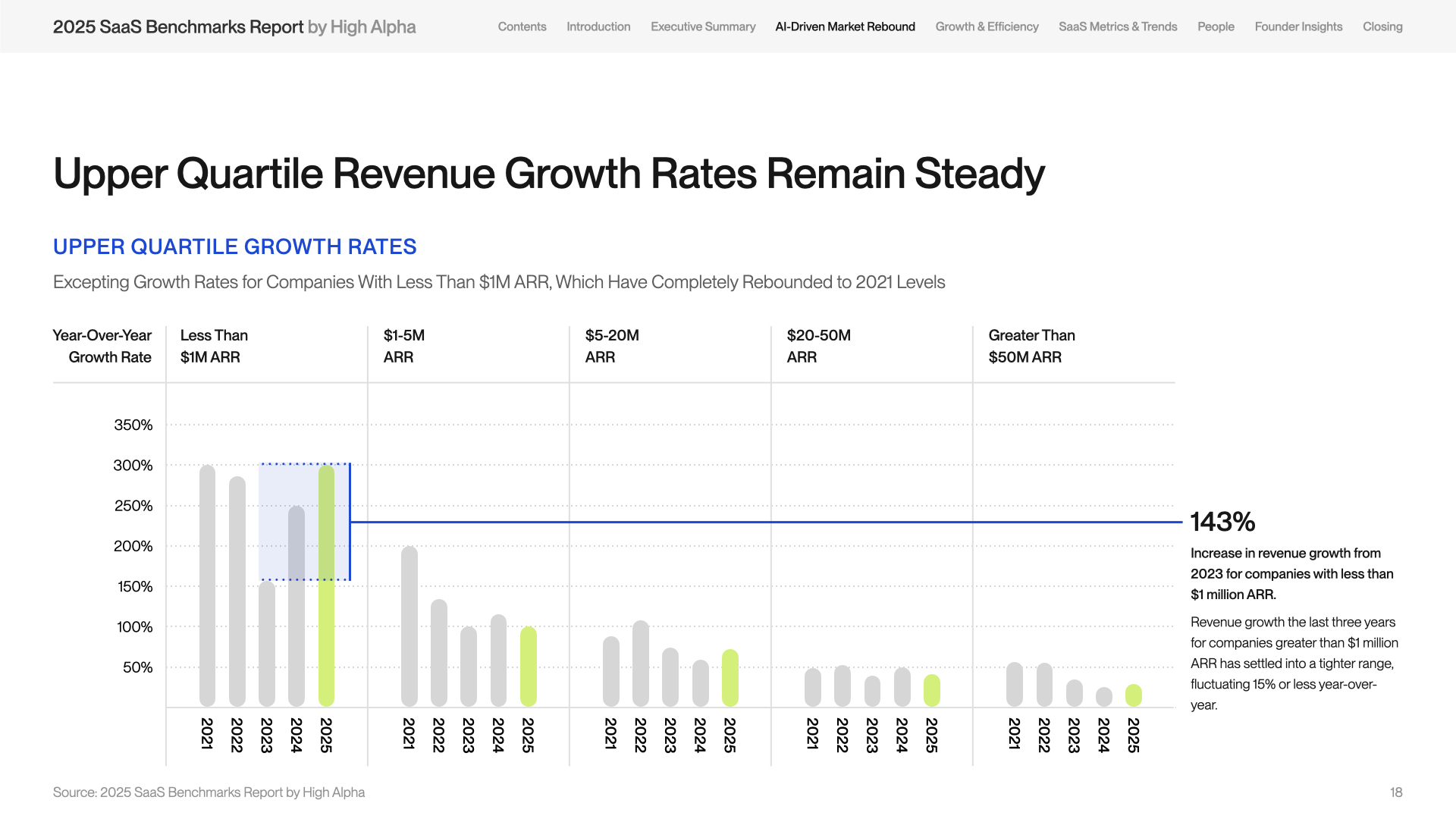
The market is showing a trend of continued stabilization in growth rates, with upper quartile companies maintaining impressive momentum. The growth numbers for 2025 are not far off from 2024 growth rates in last year’s report, with early-stage companies, in particular, showing an increase in growth rate compared to previous years.
The most notable shift, however, is in efficiency. While later-stage companies are generally maintaining their growth rate, they are doing so at a much higher ARR per employee benchmark.
The Bottom Line: With multiple years of consistent growth rates, we’re officially entering a steady state growth era.
AI Is Driving All VC Activity
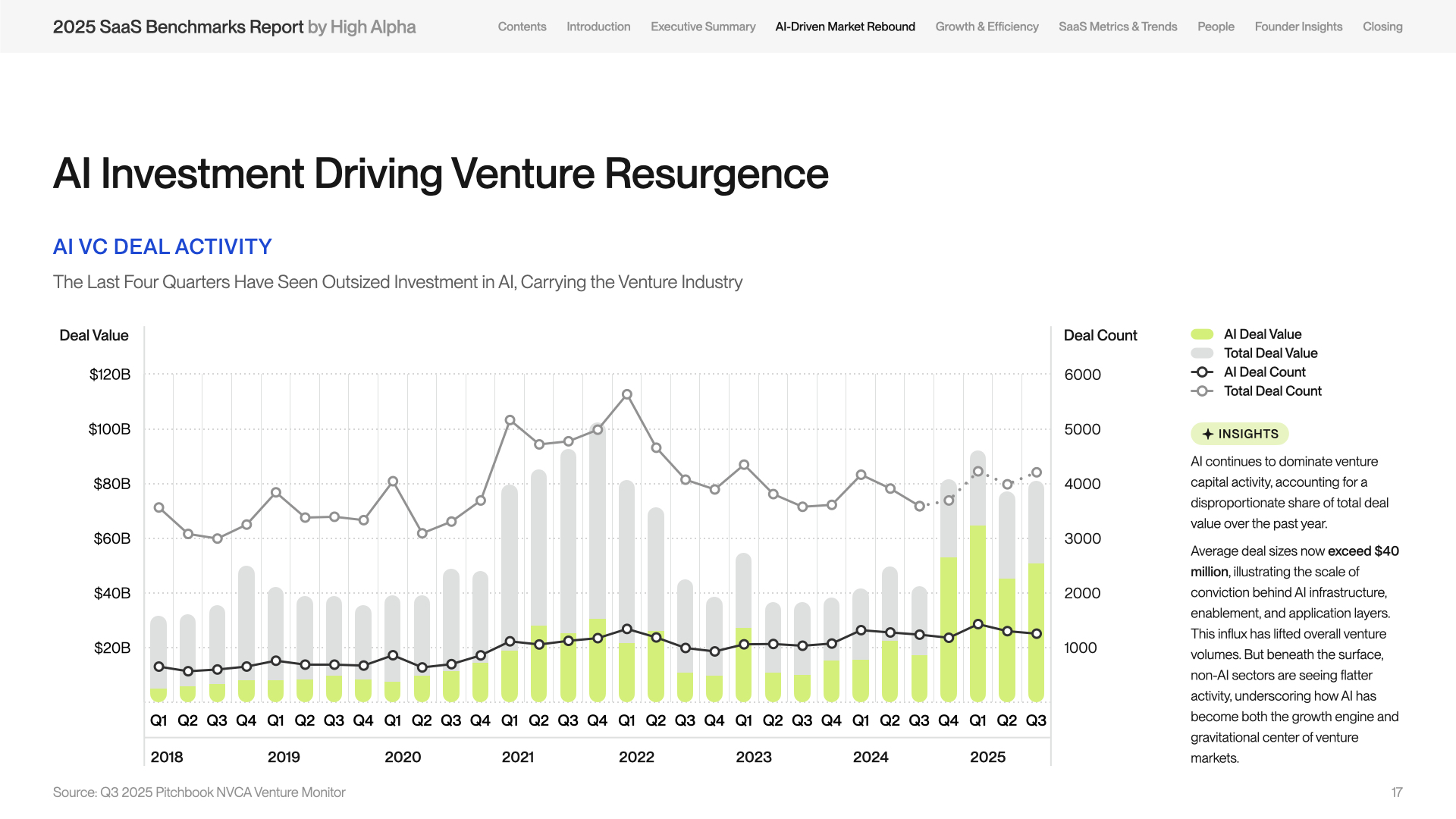
When looking at the macro venture capital landscape, it’s clear that deal value has returned to similar levels as 2021 (around $80 billion per quarter). However, deal count has not rebounded, meaning the average deal size has gone up to approximately $20 million across the spectrum.
As we discussed, the full story is one click deeper: AI is the primary driver of this venture activity. The substantial flow of capital into AI companies is creating a "world of haves and have-nots." This trend is seen as a once-in-a-career opportunity by many VCs, who are aggressively deploying dollars into this paradigm shift. Simultaneously, there is hope that the IPO window may be cracking open, which is necessary to provide the market liquidity required to drive continued funding.
The Bottom Line: Composition of deals is changing, and investment in AI is driving the resurgence in VC activity.
AI as a Growth Engine
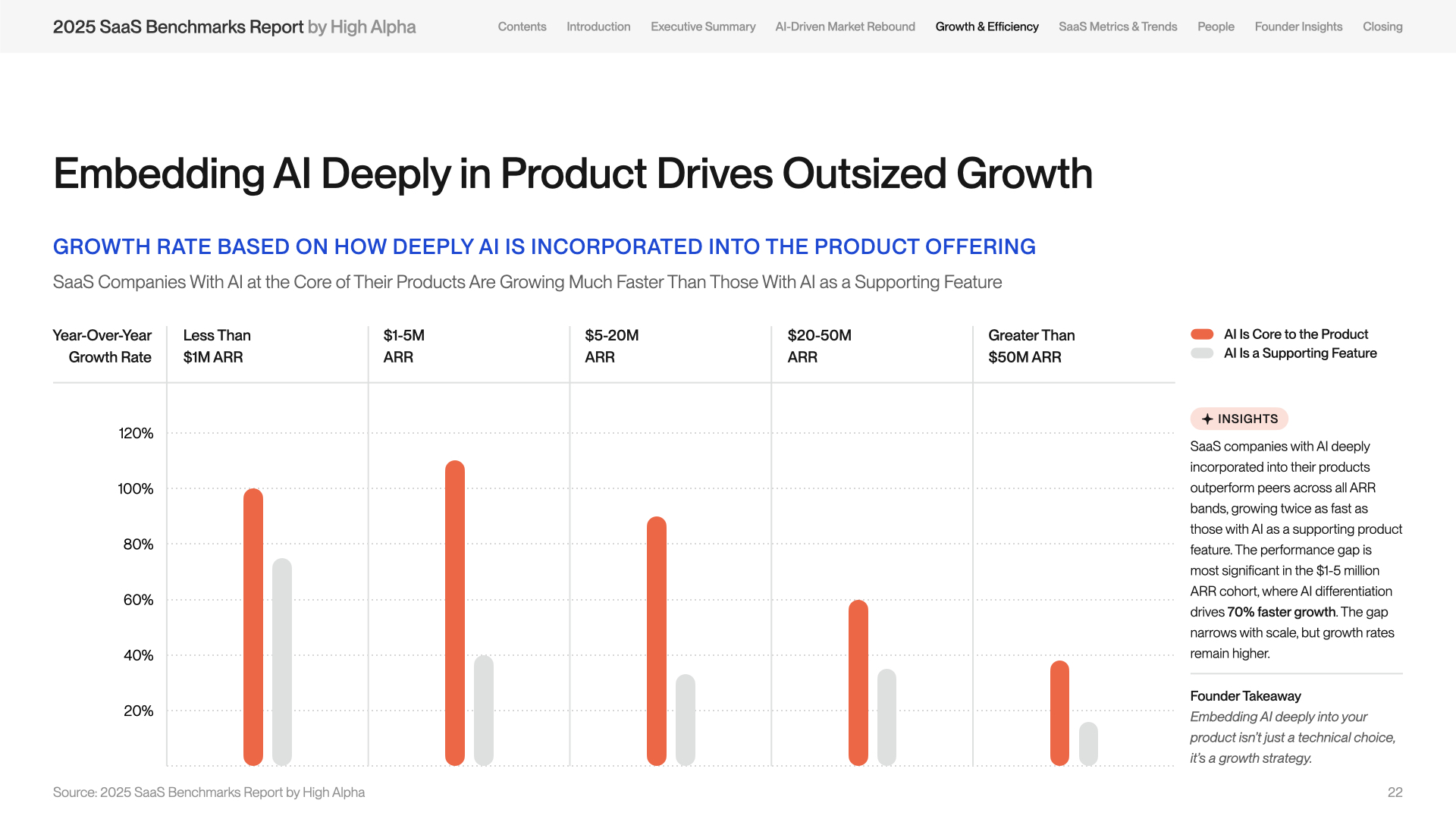
The data overwhelmingly confirms that embedding AI deeply into your product is driving outsized growth. Across every ARR band surveyed, companies where AI is core to the product demonstrated a significantly higher growth rate, with the most striking distance observed in the $1–5 million ARR band.
Monetization efforts are evolving rapidly. With 92% of companies having launched AI features or having them on their near-term roadmap, many are getting creative with how they monetize. The variety of models — from per-conversation to outcome-based — can be overwhelming. A common way this has manifested this year is through AI credits, where companies bundle a certain number of credits into subscription plans, intending for customers to eventually pay for more as they see the positive impact and ROI.
The Bottom Line: Embedding AI deeply into your product isn’t just a technical choice, it’s a growth strategy.
SaaS Metrics and Efficiency: The Lean-Team Mandate
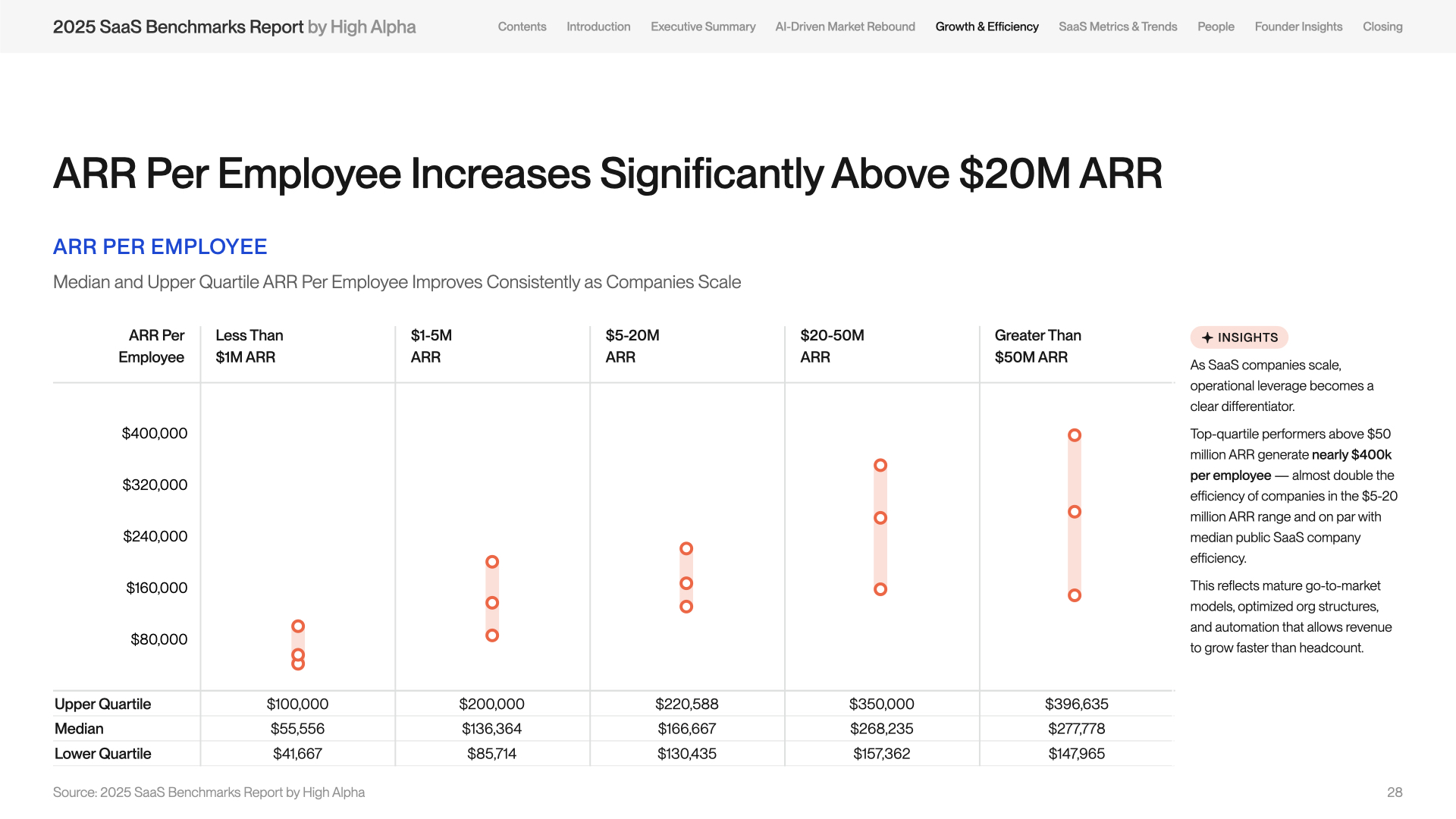
The efficiency shift is perhaps the biggest operational story of the year, driven by a combination of tighter capital availability and AI efficiency.
ARR per employee has seen significant and substantial improvements, particularly among the largest companies. Later-stage businesses are now touching nearly $400,000 in ARR per employee, which is approaching public SaaS company medians. This efficiency is directly linked to a substantial decrease in headcount since 2022. Rather than being solely driven by mass layoffs, it's often accomplished by moving slower on new hiring plans and backfills, leaning on new tooling to maintain productivity.
A compelling example is Shopify, which doubled its ARR over the last three years while operating with 30% fewer employees, tripling its ARR per employee to ~$1.3 million.
When asked specifically if they reduced headcount due to AI, larger companies reported doing so at a higher rate. We broke this down by function and found that:
- Engineering was hit hardest at 42% of companies reporting reductions
- CS & Support, and Marketing saw substantial reductions, at 27% and 26% respectively
This efficiency wave has profound implications for talent. As companies fight for fewer roles, the job market for recent computer science grads (once a "golden ticket") is seeing double the unemployment rate compared to other disciplines like biology and art history. Pretty wild.
The Bottom Line: Teams are continuing to get more and more efficient, especially at the later-stages.
The Fundamentals of Durable Growth
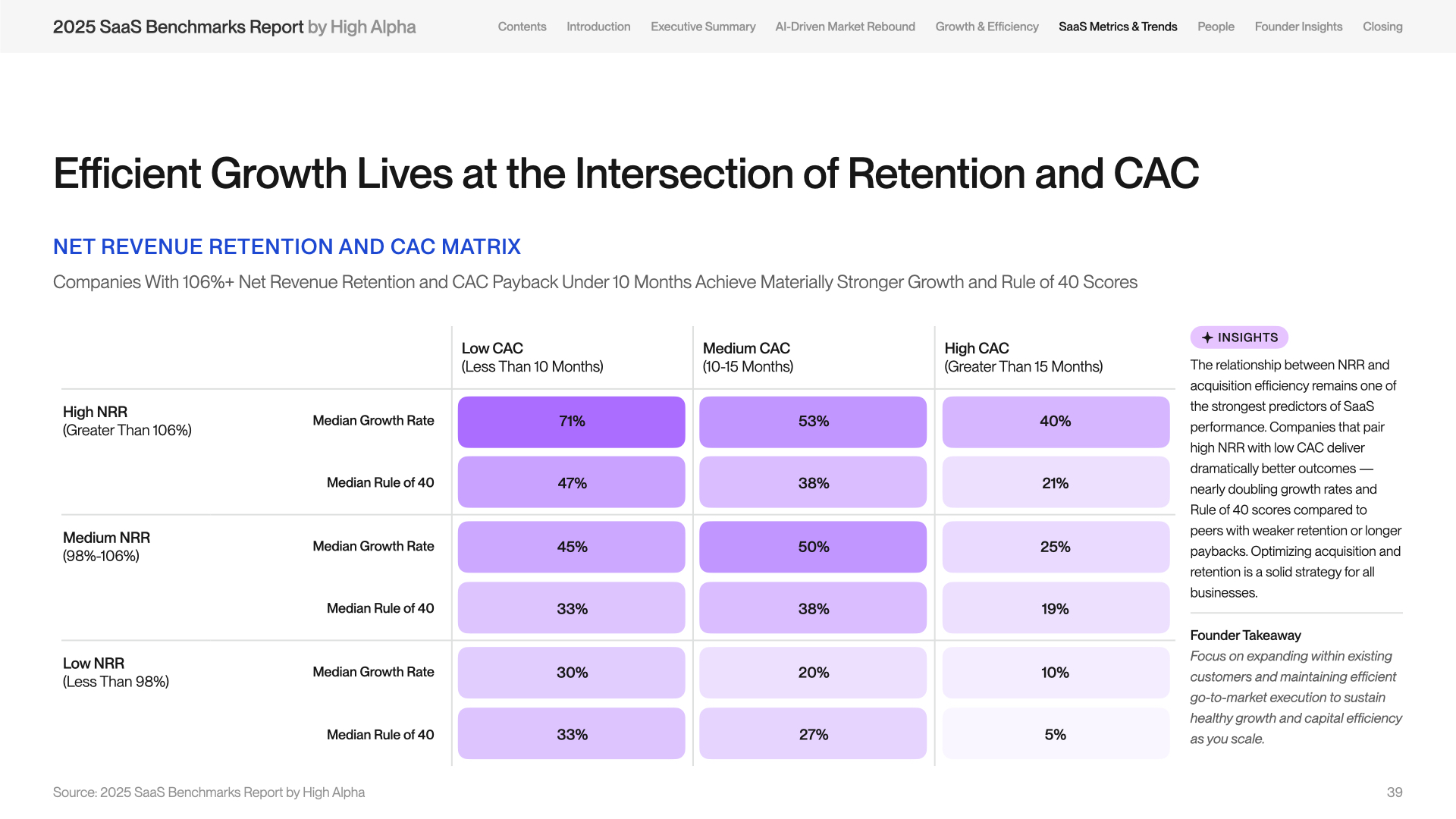
Despite the influx of new technology, the fundamentals of building a strong software business still matter. The magic formula for efficient growth lies at the intersection of High Net Revenue Retention (NRR) and managing a Low Customer Acquisition Cost (CAC) Payback period. Companies achieving this pairing reported a median growth rate of 71% with a Rule of 40 at 47%.
This relationship also helps plot different business models on a matrix:
- High NRR and High CAC generally represents the enterprise zone (requires more capital to fuel growth).
- Low CAC and Low NRR showcases a high-velocity PLG (Product-Led Growth) zone.
This growth trajectory relies heavily on the expansion motion. While acquiring net new customers drives early momentum, companies that succeed at scale understand that expansion ARR — selling into the existing customer base — is the true winner, representing the majority of net new ARR for later-stage businesses.
The Bottom Line: While a lot of things are changing, some are not. High NRR and low CAC payback is still a formula for successful outcomes.
Founder Insights

We also gained insight into the tactical and psychological landscape of the founder.
The biggest jump in what keeps founders up at night this year was AI strategy. While GTM and product execution remain the top concerns, the need for AI talent — someone who is AI-fluent and can drive real organizational change — has become a pressing concern as product execution difficulty has decreased.
On the GTM front, the most effective motions are surprisingly the "anti-AI": the human, in-person events and intimate dinners. This contrasts with the massive digital push, highlighting that real-world interactions are a competitive advantage. This ethos also applies to personal brand: building a founder-led evangelism motion is no longer seen as a negative, but a true asset and a powerful GTM flywheel.
Finally, in fundraising, the data reinforces the need to think strategically about the time to raise. Founders who start off meeting with firms well in advance of a raise, qualify each other, and then execute on the plan they established, are more likely to successfully close their round.
The Bottom Line: While there’s a larger push for adopting AI, there’s also a desire to ditch the robots — whether that be through events, dinners, etc.
Wrapping Up: A Time for Optimism and Innovation
The 2025 SaaS Benchmarks Report paints a picture of a dynamic, rapidly evolving industry. Driven by the AI revolution, we are seeing unparalleled efficiency and a dramatic shift in how companies are structured, sold, and monetized. This is a remarkable time to be building software, a fact reflected in the soaring founder optimism reported in the survey.
Download the full 2025 High Alpha SaaS Benchmarks Report to benchmark your company's performance and prepare your business for the changes ahead.
